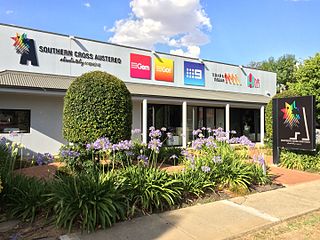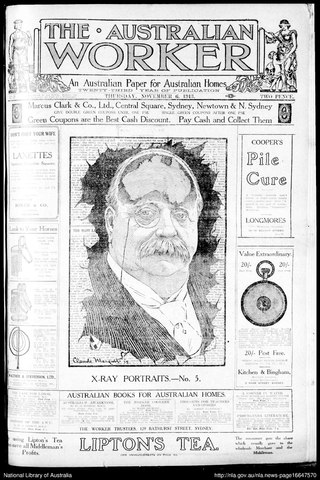Related Research Articles

Thunderbolt is a 1910 film in the genre of "outlaw" films at the time that tended to glorify the life of the outlaw "Bushrangers" that roamed the Australian outback in pre-commonwealth days. Shortly after this film was made, the government of New South Wales banned the manufacture of this type of film on the basis that they were promoting crime.

Cootamundra, nicknamed Coota, is a town in the South West Slopes region of New South Wales, Australia and within the Riverina. It is within the Cootamundra-Gundagai Regional Council. At the 2016 Census, Cootamundra had a population of 6,782. It is located on the Olympic Highway at the point where it crosses the Muttama Creek, between Junee and Cowra. Its railway station is on the Main Southern line, part of the Melbourne-to-Sydney line.
The Limelight Department was one of the world's first film studios, beginning in 1898, operated by The Salvation Army in Melbourne, Australia. The Limelight Department produced evangelistic material for use by the Salvation Army, including lantern slides as early as 1891, as well as private and government contracts. In its 19 years of operation, the Limelight Department produced about 300 films of various lengths, making it one of largest film producers of its time.

The Rock is a town with a population of 1,347, in the Riverina region of southern New South Wales, Australia, in Lockhart Shire. It is 32 kilometres (20 mi) south-west of Wagga Wagga on the Olympic Highway.

In New South Wales, Australian rules football dates back to the colonial era in 1866, with organised competitions being continuous since the 1880s. Today, it is popular in several regions of the state, including areas near the Victorian and South Australian borders—in the Riverina, Broken Hill, and South Coast. These areas form part of an Australian cultural divide described as the Barassi Line. To the east of the line, it is known as "AFL", named after the elite Australian Football League competition. AFL NSW/ACT is the main development body, and includes the Australian Capital Territory.

Coolamon Shire is a local government area in the Riverina region of south-western New South Wales, Australia. The Shire comprises 2,433 square kilometres (939 sq mi) and is located adjacent to the Newell Highway and the Burley Griffin Way. The Shire includes the towns of Coolamon, Ganmain, and Ardlethan, and the villages of Matong, Marrar, and Beckom.

Carabost is a foresting community in the southeast part of the Riverina. It is about 16 kilometres north west of Rosewood and 22 kilometres southeast of Kyeamba.
Urangeline is a village community in the central part of the Riverina. It is situated by road, about 9 kilometres north from Urangeline East and 16 kilometres north east from Bidgeemia.

Milbrulong is a locality in the central east part of the Riverina region of New South Wales, Australia.
Osborne is a village community in the central east part of the Riverina. It is situated by road, about 15 kilometres south from Lockhart and 19 kilometres (12 mi) west from Woodend.

Triple M Riverina is an Australian radio station which transmits on 1152 kHz on the AM band. It is licensed to the city of Wagga Wagga, New South Wales. The station was originally owned by Eric Vernon Roberts and his second wife Ida Annie "Nan" Roberts, who were both formerly school teachers in Narrandera. Both the studio and 100 watt AWA transmitter were originally located in the upper storey of the former Hardys' Building in Fitzmaurice Street overlooking the Wollundry Lagoon. A replacement transmitter of 2,000 watts, making 2WG one of the most powerful in Australia, was built by his brother Phil Roberts, on the Oura Road Transmitter site on 29 June 1932 and operated between 6.00 am and 11.00 pm. By June 1979 the transmitter site was located at coordinates 35° 8' south; 147° 22½' E, approximately 200 metres east of the Olympic Highway and 200 m. north of Trahairs Road.

Arthur "Jack" Verge was a rugby union player who represented Australia, New South Wales and Sydney University. Playing as a fullback, Verge won both his caps for Australia in 1904 against a touring team from the British Isles. Although he was relatively light for his position, he was repeatedly praised for his tackling and all-round defensive work, and in attack, he was a fast and deceptive runner. His kicking, on the other hand, was inconsistent.

Alfred Rolfe, real name Alfred Roker, was an Australian stage and film director and actor, best known for being the son-in-law of the celebrated actor-manager Alfred Dampier, with whom he appeared frequently on stage, and for his prolific output as a director during Australia's silent era, including Captain Midnight, the Bush King (1911), Captain Starlight, or Gentleman of the Road (1911) and The Hero of the Dardanelles (1915). Only one of his films as director survives today.

The Wagga Wagga Express and Murrumbidgee District Advertiser was an English language newspaper published in Wagga Wagga, New South Wales. It was the first newspaper to be published in Wagga Wagga, and was in circulation from 1858 to 1939.

The Australian Worker was a newspaper produced in Sydney, New South Wales for the Australian Workers' Union. It was published from 1890 to 1950.
Bismark Convoy Smashed!, also known as Battle of the Bismark Sea, is a Second World War 1943 Australian documentary newsreel film about the Battle of the Bismarck Sea on 2–3 March, an engagement which resulted in the claimed destruction of 22 Japanese ships, their crews and 15,000 soldiers. Actual Japanese losses were rather less, but still devastating.
Albert Anderson was an Australian rules footballer who played for the St Kilda Football Club and Richmond Football Club in the Victorian Football League (VFL).
Conrad Caesar ten Brink was an Australian rules footballer who played with Essendon in the Victorian Football League (VFL).
William Stanley (1820–1902) was an English-born Australian classical music composer, conductor and performer.
References
- 1 2 "NEWS OF THE DAY". The Age . No. 14798. Victoria, Australia. 12 August 1902. p. 4. Retrieved 2 October 2020– via National Library of Australia.
- ↑ "Australia's First Film Studio" at Salvation Army
- ↑ "SALVATION ARMY ENTERTAINMENT". Wagga Wagga Express (NSW : 1879 - 1917) . NSW: National Library of Australia. 25 July 1903. p. 2. Retrieved 29 June 2015.
- ↑ "THE SALVATION ARMY". Wagga Wagga Express (NSW : 1879 - 1917) . NSW: National Library of Australia. 30 July 1903. p. 2. Retrieved 29 June 2015.